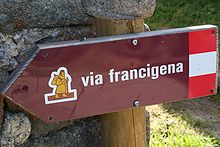Saturday, August 4, 2012
Being a Pilgrim By Staying at Home: The Habit of Attention
Somewhere along the road between Lucca and Rome, my vision changed. It got sharper, clearer – and that’s saying something for someone who had eye surgery at the age of five and spent the rest of childhood in a series of skin-colored eye patches and bifocals. Vision has been both a struggle – and subject of endless fascination.
How could pilgrimage improve such shaky eyesight? Quite simply: I had to pay attention.
Pilgrims walk with eyes wide open. We look for waymarkers to stay the course. In Spain we trained our eyes to notice yellow arrows, which pointed the way forward. In Italy, where the route was less-traveled and more poorly marked, we scoured the landscape for burly brown pilgrims with staff in hand and red banner overhead. Pilgrims pay attention to the path.
We register anything blocking it: the stray rock that could trip us, cars that buzz by at dizzying speeds, a dog untended – and unchained. Pilgrims pay attention to problems.
We notice landscape: the olive groves and vineyards we passed through, the sudden sighting of Lake Bolsena, whose breezes we felt long before we caught sight of its waters, the dome of St. Peter’s as we approached Rome, and always always always: elevation of the road ahead. “The only problem with these damned hill towns,” I remarked at the end of a day as we climbed into one, “is that they’re all on hills....” We’d hiked quite literally “under the Tuscan sun” all day. It beat down on us from above; it radiated up into our faces from white gravel paths and black macadam. The sun stole my energies – and sense of humor. At least temporarily. But pilgrims pay attention to landscape.
We survey the terrain of the spirit. Each town had one. My hiking buddy Tara and I sought it out, hiking around town at the end of even an arduous day. We were trying to figure out, as I put it, “how this place works.” How do they mark their houses? Who lives in them? Where do the men hang out? Where do the women congregate?
We saw lots.
*In Acquapendente we watched a funeral procession filed past, the mourners on foot, the coffin in a slow-moving black hearse. We found three women in a doorway, one crocheting, one waving the flyswatter, one carrying the conversation.
*We sat in the square at Ponte a Cappiano, watching our lingerie flap in breeze of a window in our hostel a block away – literally, on the ponte or bridge across a canal. Tara sketched; I wrote; the town’s youth cheered wildly for the Italians playing in the World Cup; the old men sat at another café on the other side of the street, regarding us and our laundry and all the commotion.
*Toward the end of our hike, I stalked the narrow streets of the medieval city, trying to imagine how it might have worked in the 16th century. A medieval fair was in progress, and people brushed past me in all manner of medieval regalia, aiding my imagination.
Pilgrims pay attention to the landscape of the spirit.
Finally, I noticed the inner landscape, where its surfaces were smooth or rough. I noticed where the path had been straight-forward, where it was more circuitous. I regarded the kind and quality of markers, whether yellow arrows or burly pilgrims – or still other pointers. I observed obstacles that had stalled or impeded steady forward motion. Finally, I lifted up the signs that had pointed the way forward: an opportunity that had come my way unbidden, a series of “coincidences” that, under closer inspection, weren’t really random, a desire denied whose fulfilment would have darkened the spirit. Some of these waypoints turned out to be people: I saw their faces more clearly along the way – and gave thanks for their guidance.
Pilgrims pay attention to the landscape of the spirit, and that habit of attention persists, even and especially back home.
Not perfect vision – but vastly improved.
Subscribe to:
Post Comments (Atom)

No comments:
Post a Comment